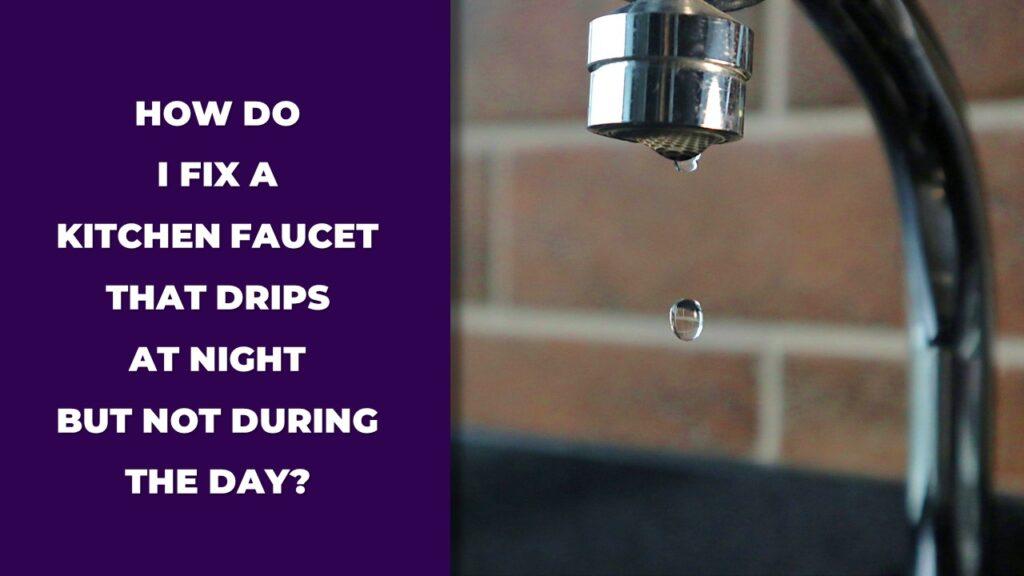
If your kitchen faucet only drips at night, the cause is usually higher water pressure when the system is idle or a worn part inside the faucet—like a washer, cartridge, or O-ring. It might be quiet all day, but that pressure shift after dark can sneak through tiny gaps and cause a steady drip.
It’s a frustrating problem, especially when it shows up during the one time you’re trying to relax or sleep. The good news? It’s fixable—and you probably don’t need to call a plumber to deal with it.
We’ll talk through why it happens, how to figure out what’s actually going on, and how to fix it step by step. I’ll also cover what tools you’ll need, how to tell when it’s time to replace the faucet, and a few ways to quiet it down until you get around to the real fix. It’s also worth noting that faucet configuration—especially when comparing styles like widespread vs centerset faucet—can influence how easy the fix is or whether replacement is more practical.
What Does It Mean When Your Faucet Only Drips at Night?
If your faucet only drips at night, it usually means the water pressure rises when no one is using water, which makes small leaks more noticeable. The worn part inside your faucet might hold up fine during the day, but as soon as things get quiet and the system rests, the drip begins.
Now that doesn’t mean your faucet is perfectly fine during the day—it just means the issue is easier to hide when water is flowing more regularly. Depending on your setup, especially with size differences like a 4-inch vs 8-inch faucet, pressure handling and spacing may also play a role in how parts wear over time.
Also, let’s not ignore the fact that a quiet house makes every sound louder. That drip you barely notice during lunch can feel like a hammer tapping on your brain at 2 a.m.
Bottom line: your faucet is already leaking. You just don’t really hear it until things slow down and the conditions allow it to slip through.
Why Does a Kitchen Faucet Leak at Night But Not in the Day?
A kitchen faucet might leak at night but not during the day because water pressure tends to increase after dark. With less demand across the plumbing system, the pressure builds—and that can push water through small weaknesses in your faucet that don’t act up when the pressure’s lower.
Here’s a closer look at what could be going on:
- Higher water pressure at night: When no one’s using water (showers, appliances, neighbors included), pressure builds up inside the pipes. That’s when your faucet’s weakest points are put to the test.
- Temperature drops in the evening: Cooler nighttime air can slightly shrink the metal parts in your faucet or pipes, opening up micro-gaps where water can escape.
- Silent house syndrome: During the day, you’ve got background noise to drown it out. At night, that faint drip suddenly becomes a mini drumbeat.
- Residual pressure from water heaters: If your leak is from the hot side, pressure buildup from your heater sitting idle could force water through a weak seal.
- Internal wear that responds to rest: Some faucet parts don’t leak when in use but lose their grip after hours of inactivity. And if you’re dealing with more than just a drip—say your kitchen faucet randomly turns on by itself—that may point to a separate issue in the sensor or control valve.
So no, it isn’t you imagination going wild, your faucet is just reacting to pressure changes and resting conditions that aren’t there during your busy, water-using day.
What Are the Most Common Parts That Cause Drips at Night?
The most common parts that cause nighttime dripping are washers, cartridges, and O-rings. These components take the most wear and are usually the first to give out when pressure builds while your faucet is sitting idle.
Here’s a breakdown of what could be behind that late-night leak:
- Washer: Found in compression faucets, this rubber disc creates a tight seal when you turn off the tap. When it wears down, water can sneak through—especially at night when pressure rises.
- O-ring: A tiny rubber ring that seals the base of the spout or valve stem. If it cracks or dries out, it can let just enough water through to create a slow drip.
- Cartridge: Common in modern single-handle faucets. When the cartridge wears out or mineral deposits build up inside, it can leak when the faucet isn’t in use.
- Valve seat: This is the part the washer presses against to stop water flow. If it’s corroded or gunky, even a new washer might not fix the drip.
- Packing nut or stem screw: These secure parts inside the faucet. Over time, they can loosen or shift, especially if the faucet’s been heavily used.
Most of these parts are cheap and easy to replace once you know what you’re looking at. And often, just fixing one of them is enough to shut the drip up for good. While doing this, make sure you’re not confusing component types—many people overlook the difference between faucet hose and dishwasher hose, which could lead to fitting the wrong part.
How Do I Fix a Kitchen Faucet That Drips at Night?
To fix a kitchen faucet that drips at night, check the faucet handle, shut off the water supply, take the faucet apart, and replace worn internal parts like the washer, cartridge, or O-ring. Then reassemble the faucet and test again after dark.
If that drip’s been messing with your sleep, here’s a simple step-by-step breakdown to help you fix it without calling in backup:
- Step 1: Double-check the faucet handle—is it fully turned off?
Sometimes the handle isn’t shut all the way—especially if the threads are worn. Turn it off firmly but don’t overdo it. If it still drips, move on. - Step 2: Turn off the water supply and disassemble the faucet
Look under your sink and twist the shutoff valve clockwise. Then open the faucet to let leftover water drain out. If your faucet has a metering cycle built in—like some commercial or timed kitchen faucets—you’ll want to understand how that works before opening it up, as the internal layout can be slightly different depending on the metering cycle in a faucet design. - Step 3: Replace the washer, cartridge, or O-ring depending on your faucet type Compression faucets usually need a new rubber washer. Cartridge or disc-style faucets may need their internal cartridge swapped. Worn O-rings are also common leak culprits and super cheap to replace.
- Step 4: Clean mineral buildup or corrosion from the valve seat
Grab some vinegar and a cloth, and gently clean the valve seat where the washer or cartridge sits. If the corrosion is bad, you may need a valve seat wrench to remove and replace it. - Step 5: Reassemble carefully and test again at night
Put everything back together exactly how it came apart. Turn the water back on slowly, close the faucet, and listen for any drips overnight.
You don’t need to be a plumber for this—it’s mostly a matter of patience and a few common tools.
What Tools and Supplies Will I Need for This Fix?
To fix a faucet that drips at night, you’ll need a basic wrench, a screwdriver, and a replacement part like a washer or cartridge. Some vinegar, a rag, and a flashlight won’t hurt either.
You don’t need to stock a full toolbox—just a few simple items to get the job done smoothly:
- Adjustable wrench – For loosening or tightening nuts around the faucet.
- Flathead and Phillips screwdrivers – For removing the faucet handle and cover plate.
- Replacement washers, O-rings, or cartridges – Grab the right part based on your faucet type. Take the old part to the store if you’re unsure.
- Plumber’s grease – A little dab on moving parts helps prevent future leaks.
- White vinegar and a toothbrush – For cleaning hard water buildup or rust from the valve seat.
- Small towel or container – To catch any water left in the lines.
- Flashlight – Because the underside of a sink never has great lighting.
- Phone camera – Snap photos during disassembly so you know exactly how to put it back together.
Once you’ve got these on hand, the fix becomes a whole lot easier. No surprises, no mid-repair panic trips to the store.
Can I Stop the Dripping Temporarily Until I Fix It?
Yes—you can temporarily stop a faucet from dripping by wrapping a rag around the spout, shutting off the water supply under the sink, or relieving pressure by opening another faucet nearby.
These quick fixes won’t solve the problem long term, but they can save your sanity for a few nights.
One trick that works surprisingly well is wrapping a sponge or small towel around the spout. It soaks up the water and, more importantly, muffles that annoying dripping sound.
If you want the drip to stop completely, turn off the shutoff valves under the sink. Just twist them clockwise. This cuts the water flow to that faucet altogether until you’re ready to work on it.
Another option—open a nearby faucet just slightly. This can release some of the built-up pressure in your plumbing and help reduce or even stop the drip for a while.
None of these are perfect fixes, but they’ll give you some peace and quiet until you’re ready to take the faucet apart and get your hands dirty.
How Can I Tell If It’s Time to Replace the Faucet?
If your faucet keeps leaking even after repairs, shows signs of corrosion, or feels loose or unstable, it’s probably time to replace it. When small fixes stop working, it usually means the faucet’s internal components are too far gone.
Now, if you’ve already swapped out the washer, cleaned the valve seat, maybe even installed a new cartridge—and it’s still dripping—you’re not doing anything wrong. Some faucets just reach the end of their run. They get worn down after years of daily use, especially if your home has hard water or fluctuating pressure.
Another red flag is visible damage. If you notice pitting on the metal, a loose handle that won’t tighten, or rust where the base meets the sink, that’s your faucet quietly saying, “I’m tired.” And if it’s leaking from more than one place—like both the spout and underneath—that’s usually a dealbreaker.
Newer faucets also tend to be more efficient, easier to maintain, and less prone to those random late-night drips. If you’re already leaning toward an upgrade, it might be worth exploring some of the best high-end kitchen faucets that not only fix your drip issue but also add serious function and style.
Can a Dripping Faucet at Night Raise My Water Bill?
Yes, a dripping faucet can quietly increase your water bill—especially if the leak continues for weeks or months. Even a slow drip can waste hundreds of gallons of water if left unchecked.
Let’s do some quick math. One drip every two seconds adds up to about 2,000 drips per day. That’s roughly 4–5 gallons of wasted water every 24 hours. Over a month, that’s about 120 to 150 gallons, depending on how fast it’s dripping.
Now, in 2025, the average cost of water in the U.S. sits around $0.012 per gallon (based on public utility estimates). That means a dripping faucet could add about $1.50 to $2.00 per month to your bill. Doesn’t sound huge—but if you’re paying for hot water, that number doubles because your water heater’s working too.
The bigger issue is that those small leaks often get worse. What starts as a $2-per-month problem can turn into higher bills, water damage under the sink, or even mold if it seeps where you can’t see it. So yeah, ignoring a drip isn’t just annoying—it’s a quiet waste of money.
How Do I Prevent My Kitchen Faucet from Leaking Again?
To prevent your kitchen faucet from leaking again, treat it gently, clean it regularly, and replace small parts like washers and O-rings before they fail.
Here’s a list of easy habits to help you stay ahead of future leaks:
- Don’t crank the handle shut – Just turn it off until you feel resistance. Over-tightening wears out washers and threads.
- Clean the aerator every few months – Mineral buildup here can mess with flow and pressure, stressing internal parts.
- Inspect your faucet during seasonal cleanups – Look for any looseness or corrosion. Early fixes are easier and cheaper.
- Use plumber’s grease when replacing parts – A dab during repair helps seals last longer and makes future fixes smoother.
- If you have hard water, consider a softener – it reduces mineral deposits inside the faucet, which means fewer internal failures. Or, better yet, you could go with one of the best kitchen faucets for hard water, which are built specifically to handle scale and sediment without wearing out quickly.
- Replace worn washers and O-rings every few years – These are small, cheap, and take just a few minutes to swap.
A little care here and there can keep your faucet working smoothly for years. And it’ll keep you from hearing that drip-drip sound just as you’re trying to fall asleep.
Wrapping It Up!
A faucet that only drips at night isn’t just being weird—it’s reacting to pressure changes and worn-out parts that finally give in once the house quiets down. And while it feels like a mystery, it usually comes down to a washer, O-ring, or cartridge that’s past its prime.
Fixing it isn’t rocket science. With a screwdriver, a wrench, and maybe a quick trip to the hardware store, you can get it sorted in under an hour. Just follow the steps: shut off the water, pull the faucet apart, swap the damaged part, and test it again overnight.
If the leak keeps coming back even after a few attempts, or your faucet’s starting to look rough around the edges, don’t overthink it—just replace the whole thing. Sometimes that’s the better long-term call.
And if you’re not ready to fix it right away? That’s fine too. Wrap the spout, kill the water under the sink, and give yourself some peace until you’re ready to get in there. No stress. Just one small drip at a time.
Related FAQs
Why does my kitchen faucet only drip at night?
At night, water pressure rises due to low demand. That extra pressure can sneak through worn washers or loose seals in your faucet.
Can a dripping faucet really cost me a lot of money?
Yes! A slow drip can waste up to 150 gallons a month—especially if it leaks from the hot side. That’s water and energy bills going up.
What part usually causes a faucet to leak overnight?
Most often, it’s a worn washer, faulty cartridge, or cracked O-ring. These small parts lose grip under increased nighttime pressure.
Is it safe to leave a dripping faucet overnight?
It won’t cause an emergency, but it can lead to mold under the sink, water waste, and long-term faucet damage if ignored.
Do I need to call a plumber for this?
Not always. If you’re comfortable using basic tools, you can fix most leaks yourself. But if the faucet’s very old or leaking from multiple spots, a plumber may be worth it.
How do I know if I should replace the faucet entirely?
If you’ve tried fixing it multiple times, it’s more than 10 years old, or leaking from more than one place—it’s probably time to replace it.

Dylan Foster is a family man with years of hands-on experience in plumbing, household maintenance, and fixing everyday issues around the home. A former plumber, Dylan knows what it’s like to deal with tricky leaks, worn-out parts, and all the little problems that pop up in a house. From plumbing repairs to kitchen fixes and garden hose setups, he’s done it all. Dylan shares real-world solutions to help others keep their homes running smoothly and avoid costly mistakes.




